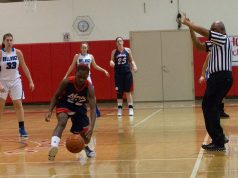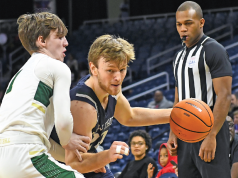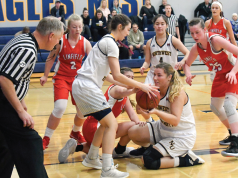If you watch a basketball game closely on TV, you are bound to hear multiple whistle blasts several times. Multiple tweets are not disallowed by rule, but they are only supposed to be used in unusual situations.
Is the practice increasing? Why do officials hit the whistle more than once? Is it necessary? Under what circumstances?
When it comes to using the whistle, the point is to stop play and rule on the action. That typically takes one quick, hard blast. Get the attention of the players on the court, and most importantly, the table. Stop the clock. Give your signal.
In most circumstances, that is how the majority of official’s approach and execute their rulings. Sometimes you will hear multiple tweets. What is going on?
Charlene Curtis, who has assigned women’s officials the past eight years for the Colonial, Atlantic Coast, Big South and Southern conferences, never officiated, but coached at the Division I level and did a stint as a TV analyst as well. She brings a unique background to women’s college basketball officiating and looks at the whistleblowing issue as a situational one: standard plays and unusual ones.
“The whistle stops the clock and the play,” Curtis said. “The players are supposed to stop, but if they don’t, you need to get their attention.” An example where the players might continue to tussle is over a held ball. That situation could require more than one pop on the whistle.
“A multiple whistle is not necessary on a screen, traveling or foul. But if two players are going up and challenging each other, it might be necessary,” she said.
The mechanics manual says one blast is the standard. If you look at page 112 of the CCA women’s manual, you will find that more than one blast for unusual situations is OK. That means situations where you look to “avoid an error,” meaning, for example, that one official is about to administer the ball to the wrong team on a throw-in or the wrong free-throw shooter is at the line. “To avoid that error, you get the attention of your fellow official, using multiple tweets,” Curtis explained.
Joe Forte doesn’t know why the practice started. “Mechanically it’s supposed to be one blast,” the Big South coordinator of men’s officials said. “Officials do it to try and sell the play, but it’s not necessary. Officials should blow the whistle to stop the clock and give their signal.”
Two toots might be wanted, according to Forte, for situations where two actions occur almost simultaneously, and one of the officials seeks the attention of his partner. “It’s a form of communication,” he said. “The trail may want to get the lead’s attention if he sees a travel before a push that occurs in front of the lead. It lets the other official know you want to talk the play over.
“In the Big South, we ask our officials to give a Frank Sinatra — something smooth. We don’t want a double tweet. Most plays sell themselves. If you don’t need to do a whole lot of selling, an extra blast is unnecessary,” Forte observed.
The extra whistle happens when “guys want to sell the call. It’s annoying when you hear ‘dadadadadada’ on the whistle. We had to work with one of our guys on this and I told him, ‘You have to stop this.’ An official should only use two blasts when he’s indicating to his partner he has something and needs to take the play,” Forte added.
Longtime men’s D-I official Steve Olson tends to use a multiple whistle when he encounters secondary action or the potential for an additional foul. He’s anticipating that the next activity could be worse in a heated contest and uses the “second blow to grab attention,” he said. “Then I’ll verbally follow up with something like, ‘Knock it off, number 4.’ That gives direction to the guys to move away from the play.”
The extra whistle becomes important when the game is getting intense and the players are in a heated battle, according to Olson. “It creates an opportunity to talk and takes the emotion out of the game,” he said.
One of the biggest reasons for a second whistle is to “prevent intense play from escalating. It works for me. In some of the D-I arenas, the players can’t hear you yelling,” Olson continued, which makes the whistle more important.
Olson found himself adopting the practice of using an additional blast early in his career because he found it effective in “high-level, high-energy games. When there’s a lot of rough play, athleticism and bigger, stronger, faster athletes, it’s sometimes necessary to get their attention to stop play from escalating,” he observed.
A secondary whistle helps take the emotion out of the game. “It gives the official a chance to let the players and coaches know, ‘This can’t go on.’ Basketball is a high-emotion game. You won’t see these guys acting like that at the grocery store,” Olson said, chuckling.
The extra whistle isn’t for everyone, and whether someone uses an additional toot depends on the official’s personal techniques, according to Olson. “I use it as a measure to prevent rough play or a secondary foul,” he said.
The Whistle As A Communication Device
One can forget the whistle is a communication device. Marianne Karp didn’t. The former D-I women’s official, who retired after 20 years following the 2014- 15 season, said with a chuckle that she was “notorious for giving more than one blast.” While she didn’t start her officiating career using more than one tweet, she found herself gravitating toward it later in her career. “The whistle is all about communicating. When I double blasted it was because I needed to get everyone’s attention,” she said.
Once she got the attention of her partners, Karp took a bit of extra time to communicate with her partners what happened, which typically involved a more complicated play, like a travel immediately preceding a crash. “I’d use it when a couple of actions on the court occurred almost simultaneously,” she said.
Karp did not start out planning to hit the whistle more than once. It was an evolutionary process for her, driven by the need to provide extra information on the court. It signified “I have information for you to address a situation before something worse develops. It’s prevention,” she observed.
The goal is to get the proper ruling, according to Karp. “You can’t stand on the court and think about blowing your whistle twice,” she said, adding that knowing when to give an effective second blast “comes from experience.”
“When I had a double blast, it was effective. My supervisor might bring it to my attention later,” Karp said, laughing, “but it got everyone’s attention; we got the call right.”
Overuse
If multiple tweets are overused, they lose their impact. “It demonstrates the extra whistles are unnecessary and calls attention to the official,” Curtis said. “The ruling official might be overly hyped up or bouncing around.”
Curtis advocates one blast and reserving multiple blasts for unusual situations. “It’s not a huge problem, but I plan to emphasize the impact at camps this summer,” she said. “It’s not like people are teaching this. Officials have learned it by watching other officials. It’s almost like a stutter, if you think about it. You’re trying to tell your partner, ‘Wait, wait, wait, wait,’ and you’re going ‘toot, toot, toot, toot.’
“I plan to challenge our officials to pay attention to this issue. Our clinicians are typically more focused on other issues, but this will help clean up the game a little more,” Curtis continued.
The whistle has a purpose — to stop the action on the court and the clock. “Save the multiple whistles for the unusual. Block/charge plays, illegal screens and traveling violations are not unusual,” Curtis said.
What's Your Call? Leave a Comment:
Note: This article is archival in nature. Rules, interpretations, mechanics, philosophies and other information may or may not be correct for the current year.
This article is the copyright of ©Referee Enterprises, Inc., and may not be republished in whole or in part online, in print or in any capacity without expressed written permission from Referee. The article is made available for educational use by individuals.



















